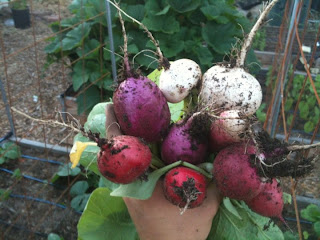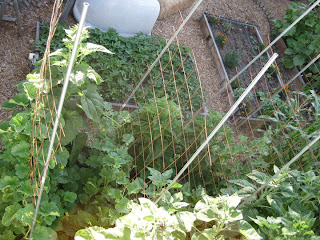Erica wrote a post entitled Wifery, Money And Not-Work, and this is my response (because the comment I started writing got long to the point of “get your own damn blog.” Oh. Wait.) So you should go read hers first, so mine will have appropiate context. It’s okay, I’ll wait.
::twiddles thumbs. eats some yogurt and granola. sips some tea.::
Okay, now that you're all caught up, we can continue.
I have a feeling this topic of the value of my contribution to the family is going to be more of an issue in my future, but I already see it sneaking its way in. Right now I work in the monetized economy, but as soon as we can swing it the plan is for me to stay home. At which point we also plan to start having kids. Frankly, we’d love to start yesterday, but I really want to be home with our kids, plus right now close to half my income would go to child care (which seems just ridiculous to me). We also want to homeschool, so having one of us home for a goodly portion of the day is going to be helpful in making that happen.
Both my parents worked full-time, and while they were blessed with reasonably flexible jobs that allowed them to be at many of my events, games, etc. growing up, I hated daycare. My mom grew up with the push to never be economically dependent on a man. While I certainly sympathize with that motivation, I view it as both of us working to support our household, just in different ways (I also have employable skills and an advanced degree, so it’s not like I have no skills on which to fall back). But I do recognize that the luxury of this distinction is afforded me by my mother’s generation and the women’s lib movement. I have options. My grandmother did not. I grew up with the understanding that I could be almost anything I wanted. I don’t think my parents imagined that I would choose to be a radical homemaker (of course, “radical homemaker” would have been a laughable term, if they could have conceived of such a thing).

But I think I digress a little. My husband is totally on board with homesteading, for which I am unceasingly grateful. He likes to joke that it gives him excuses to build things, but he really likes it for more than just that aspect. However, I do feel like he thinks I don’t do “enough” sometimes, on the days I’m home. (I work full-time, but my schedule is such that I work 80 hours in 7 out of every 14 days, so I have a few extra days home compared to traditional hours, if I don’t work overtime.) One of the issues therein is that our to-do list priorities are a little different sometimes, so we both struggle to appreciate how the other has spent the day. I’ve taken to sending him lists of what I’ve done just to show that I’m not sitting at home eating bonbons. And when he gets a little whiny about household stuff I exclaim that, yes in fact, I was eating bonbons, thank you for asking! I still see him struggle with the shiny lure that having a second monetary income holds even though he knows that we will both be happier with me home, so we’ll see how we cope when we get to the portion of the program where my being home full time is our reality. Our current struggle is with “stuff” and the paring down of consumption and spending. When I do stop working full-time outside our home it will necessitate that we tighten our belts, so we are trying to get ahead of the game and start now. It’s an ongoing discussion and negotiation.
However, I think in addition to fighting for appreciation for what we do within our families and communities, many of us also fight ourselves. We struggle to value our own contributions because we are not bring home a “real” paycheck or receiving annual reviews telling us we are worthwhile. Erica does a great job of addressing this in her post Negabucks. Sometimes it helps to see our contributions quantified.
One of the biggest challenges I foresee for me when I get to be a full-time homemaker is that I really had no examples growing up. I can recall precisely one friend growing up with whom I spent any real time with who had a SAHM; and while I loved them dearly, my perception was that her mom spent her time dusting faux flower arrangements and cooking from boxes. She undoubtedly did far more and she was an unwavering cheerleader of her kids and husband, going to all their games and events, hosting church groups, and feeding hoards of ravenous teenagers. But still, the type of wifery she lived was very different from what I do and aspire to do. It’s not that I don’t wish to be an unwavering cheerleader (does that involve reading during games, because if so I will be extra great!), gracious hostess, and feeder of hoards, but that the whole life I envision is just so different from that one example I had. And, of more immediate future relevancy, I did not see that lived out with young children. How do I balance babies, toddlers, managing a household, a large garden, a rapidly expanding menagerie, growing and preserving the bulk of our produce, feeding my family a whole-foods-from-scratch-mostly-local-and-organic diet, educating the children, loving my husband, maintaining my friendships, and keeping up some minimal amount of self-care without going bat-sh*t crazy?
Reading what I just wrote I think the real issue is the loss of community. Our mothers said “we can have it all!” and the mega corporations said “we have just the product for that!” While the radical homemaker movement is something of a backlash to that, I think the tendency is still to think that we have to do it all ourselves. I know I have struggled with this most of my life, even before moving in to the RH-UH spheres. I don’t like asking people to do things for me. I don’t like feeling like I am imposing, I don’t like risking being told “no,” and I don’t like admitting that I can’t handle it – whatever “it” is. I don’t like needing other people. The sin of pride is my most ongoing personal struggle. But if I am going to do this thing, if I want to be a radical homemaker and suburban homesteader, I am going to have to learn to lay down my pride. Lord help me.
“Back in the day” you didn’t do all these things yourself (unless, perhaps, you were a pioneer on the edge of American manifest destiny). You had a large family and a community from which to draw help and support and wisdom. I learn loads from the blogs I follow and the online communities I am a part of and I value those connections, but let’s be real – they do not take the place of having someone physically beside you, helping you can those peaches while you chat your heads off. We are starting to find and build that support network within our church and neighborhood, but it is still frustrating some days and more dispersed than I would like.
So I realize I have veered off course from Erica’s original point and questions, but I have a hard time not seeing all these things and interrelated. What do you think? Do you have a local support network with similar values? Do you struggle with asking for help?
Reading what I just wrote I think the real issue is the loss of community. Our mothers said “we can have it all!” and the mega corporations said “we have just the product for that!” While the radical homemaker movement is something of a backlash to that, I think the tendency is still to think that we have to do it all ourselves. I know I have struggled with this most of my life, even before moving in to the RH-UH spheres. I don’t like asking people to do things for me. I don’t like feeling like I am imposing, I don’t like risking being told “no,” and I don’t like admitting that I can’t handle it – whatever “it” is. I don’t like needing other people. The sin of pride is my most ongoing personal struggle. But if I am going to do this thing, if I want to be a radical homemaker and suburban homesteader, I am going to have to learn to lay down my pride. Lord help me.
“Back in the day” you didn’t do all these things yourself (unless, perhaps, you were a pioneer on the edge of American manifest destiny). You had a large family and a community from which to draw help and support and wisdom. I learn loads from the blogs I follow and the online communities I am a part of and I value those connections, but let’s be real – they do not take the place of having someone physically beside you, helping you can those peaches while you chat your heads off. We are starting to find and build that support network within our church and neighborhood, but it is still frustrating some days and more dispersed than I would like.
So I realize I have veered off course from Erica’s original point and questions, but I have a hard time not seeing all these things and interrelated. What do you think? Do you have a local support network with similar values? Do you struggle with asking for help?
















































